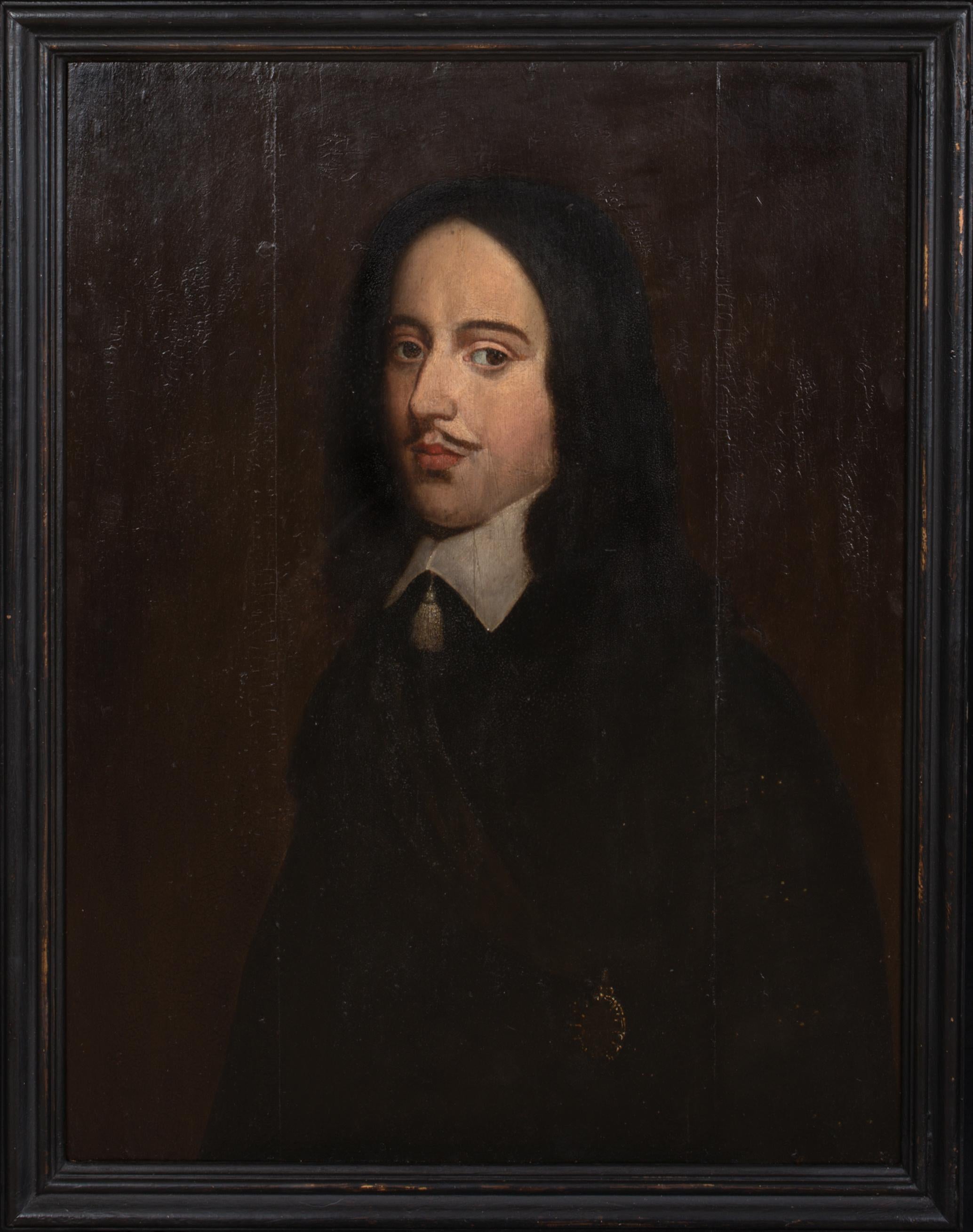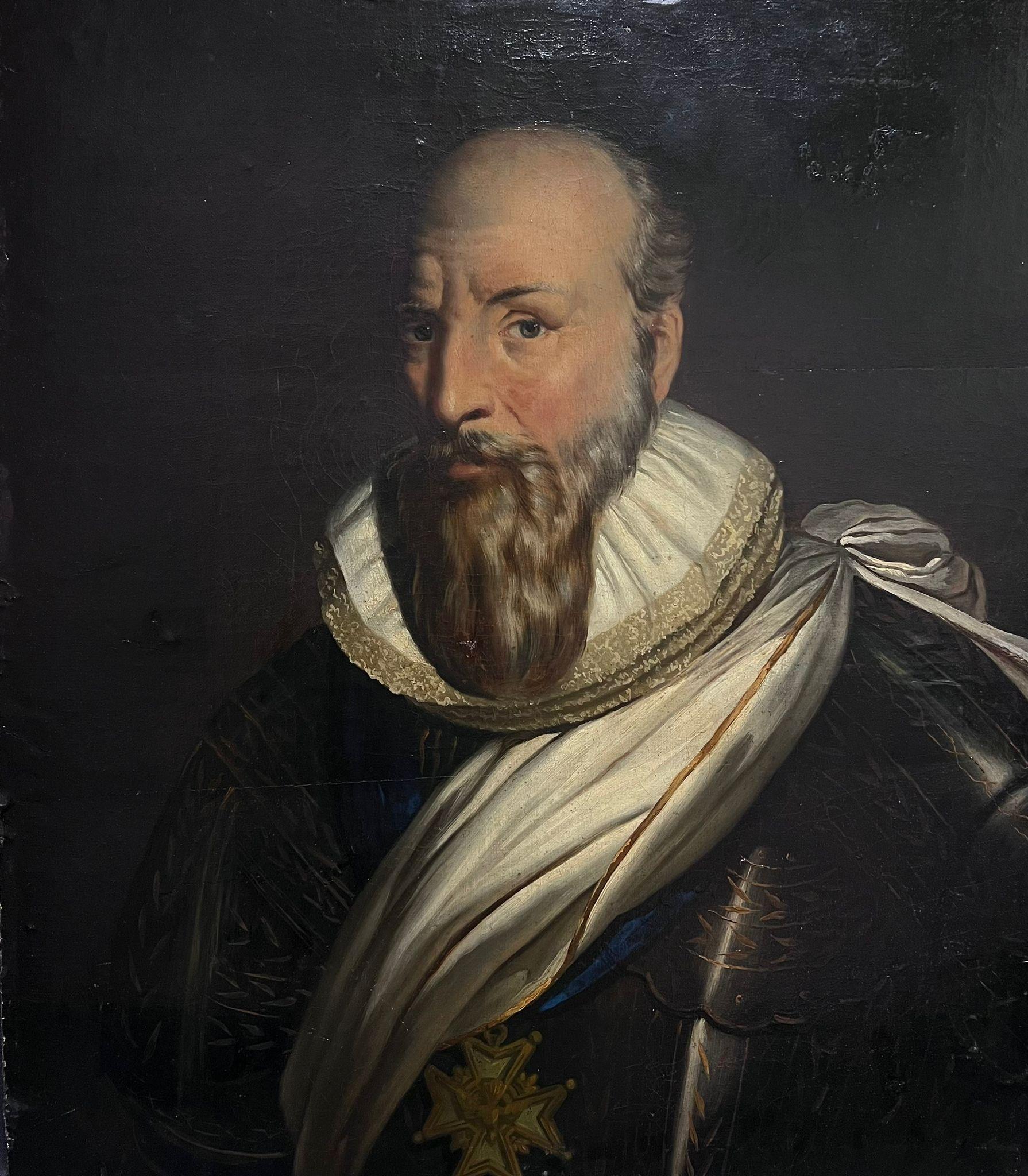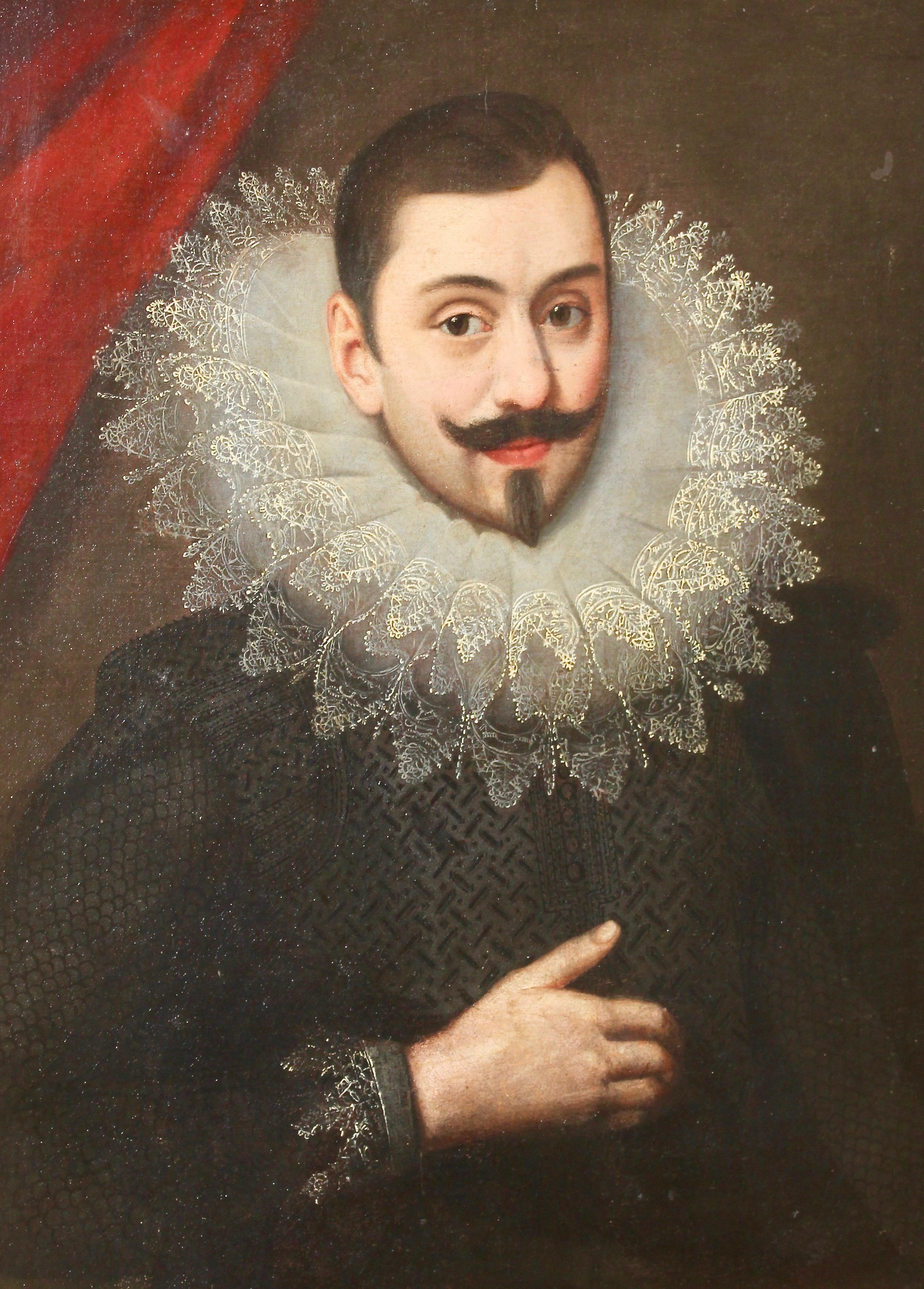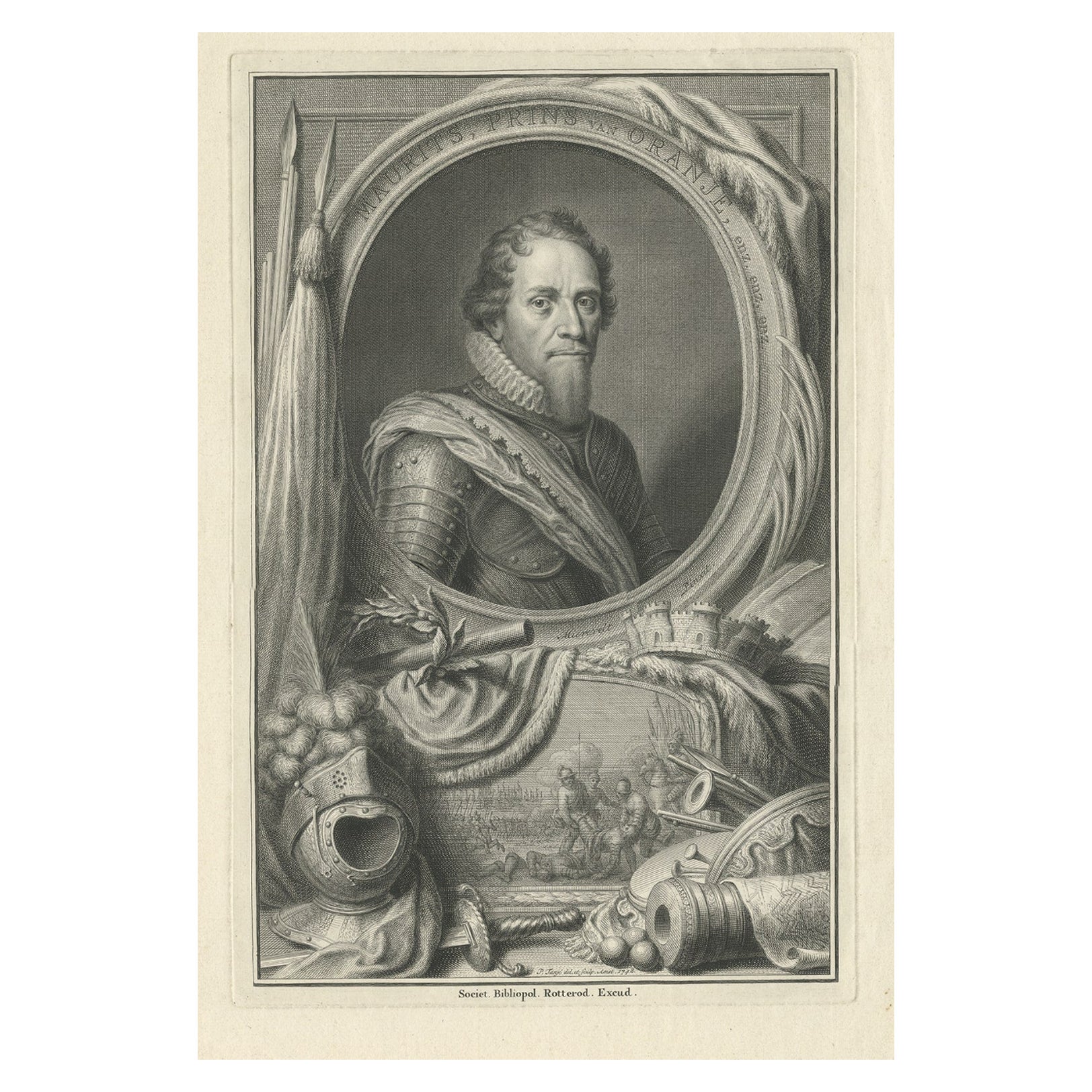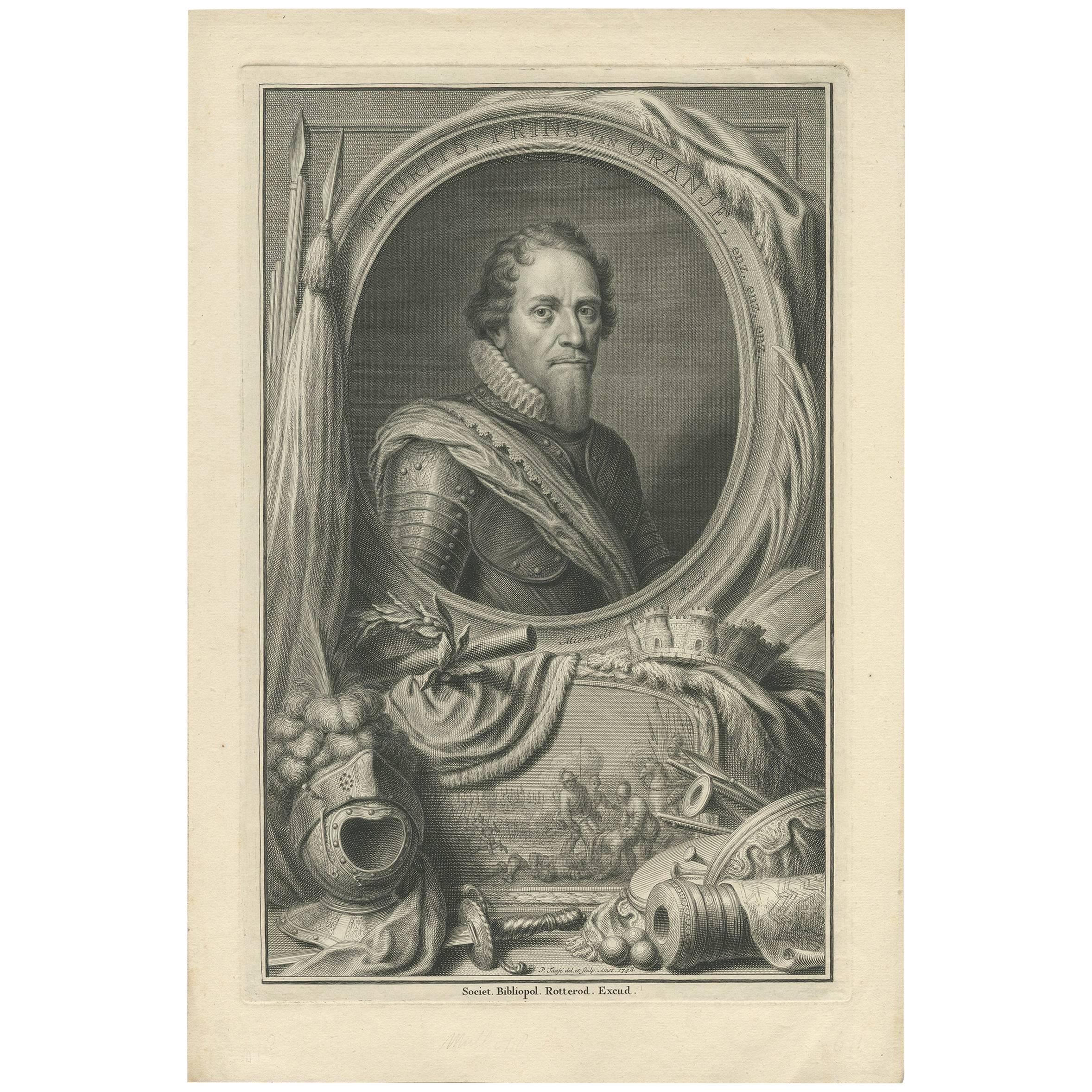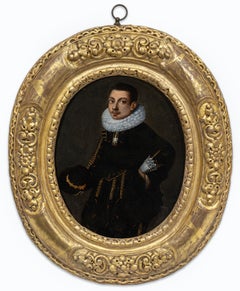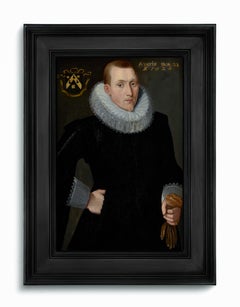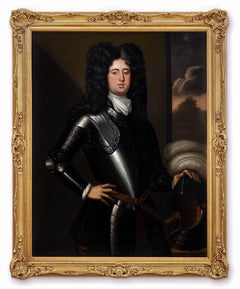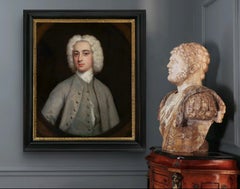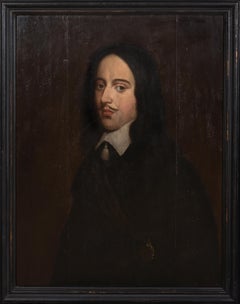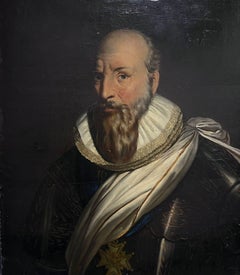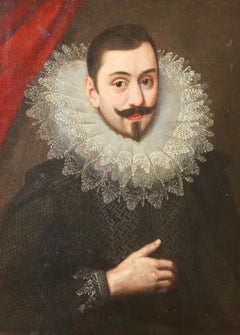Items Similar to Dutch Old Master Portrait of Maurits, Prince of Orange-Nassau, Oil on Panel
Want more images or videos?
Request additional images or videos from the seller
1 of 17
(Studio of) Michiel van MiereveltDutch Old Master Portrait of Maurits, Prince of Orange-Nassau, Oil on Panel17th Century
17th Century
$12,466
£9,050
€10,668.38
CA$17,142.62
A$19,067
CHF 9,979.26
MX$232,554.52
NOK 125,393.03
SEK 117,948.33
DKK 79,629.08
About the Item
In 1607, the Delft city council decided to commission a portrait of Stadholder Maurits of Nassau for the town hall, with Michiel van Mierevelt as the chosen artist due to the passing of the previous court painter Daniël van den Queborn. The receipt from 1608 revealed that Van Mierevelt received the substantial sum of 200 guilders for the painting, which was competed in 1607. He was also granted a six-year patent by the States-General for reproductions of the portrait in copperplate engravings, solidifying his position as the official court painter. Maurits, who was appointed stadholder after the murder of his father William of Orange, in 1584, was depicted at almost three-quarter length, wearing a richly decorated gold coloured suit of armour. The orange-red of his sash signify the House of Orange and the medallion of the Order of the Garter hangs from a ribbon on his chest.
Van Mierevelt depicted the stadholder in a very natural pose and rendered details of the composition with utmost believability. The scene therefore makes a sharp contrast with the rather stiff portrait that Van der Queborn produced about nine years earlier. Van Mierevelt's portrait was extremely successful: as early as 1607, the year of its completion, at least one replica was painted, for the States-General. In 1608 Jan Muller's print of the painting appeared, for which Van Mierevelt had been granted a patent in 1607. Dozens of other portraits of Maurits from Van Mierevelt's studio - busts, three-quarter and full-length likenesses show that the painter and his assistants probably turned-out hundreds of versions in the ensuing decades, of which our portrait, here at Titan Fine Art, is one such example. The basic concept remained the same throughout, although the facial features were sometimes modified to reflect Maurits's advancing years; the stadholder probably did not pose for the painter again after 1607.
After Delft built a new town hall in 1620, Van Mierevelt was commissioned to furnish it with four equally large portraits of Maurits's father, his two brothers and his nephew. In 1624 he supplied another three works for the town hall, making a series of eight portraits in all. These paintings probably served as an example for similar portrait galleries elsewhere.
Presented by Titan Fine Art.
Michiel Van Marivel’s contribution to portrait painting in the early seventeenth century Holland is evident through his appointment as the official artist at the Stadholder court in 1607 and his notable works capturing the likeness of prominent figures. Thus, he was responsible for the majority of portraits of the House of Orange Nassau, including Prince Maurice and his brother Fredrik Hendrik. He was the most productive and successful portraitist in Delft and apart from the many Dutch patrons, Mierevelt achieved such success that his studio became one of the largest in operation. English clientele were also very keen to commission him their portrait (and several copies to give to friends, relatives and their children). Mierevelt's legacy as a renowned portrait artist in England is evident through his notable works featuring Elizabeth of Bohemia, showcasing his talent and popularity during his time.
Mierevelt had more clientele than he could handle and his winckel was a slick operation capable of a large output with three or four fully trained assistants working with him at any one time, of which many rose to fame, including Paulus Moreelse and Jan Antonisz. Van Ravesteyn. His sons, Jan and Pieter, worked in his studio under his guidance and supervision. His meticulous attention to detail and skill in creating lifelike representations of exceptional quality continues to be recognised and celebrated today.
Provenance:
Chateau de Vouzeron, Loire, France. Built in 1887, the Chateau de Vouzeron is located 100km south of Paris in the Loire Valley region of France. It was built by Gabriel-Hippolyte Destailleur for Baron Eugène Roger (1850–1906). Destailleur had, a few years earlier, built the Franconville castle in Saint-Martin-du-Tertre (Val-d'Oise), for the Duke of Massa, half-brother of Baron Roger. It was upon seeing Franconville that the Baron commissioned Destailleur to build him a castle on a vast piece of land that he owned in the Cher. It has been registered as a historic monument since 1995.
Measurements: Height 96cm, Width 85cm, Depth 8cm framed (Height 37.75”, Width 33.5”, Height 3“ framed)
- Creator:(Studio of) Michiel van Mierevelt (1567 - 1641, Dutch)
- Creation Year:17th Century
- Dimensions:Height: 37.8 in (96 cm)Width: 33.47 in (85 cm)Depth: 2.37 in (6 cm)
- Medium:
- Movement & Style:
- Period:
- Condition:The condition is very good and can be hung and enjoyed immediately. The painting has passed a strict condition assessment by a professional conservator prior to going on sale.
- Gallery Location:London, GB
- Reference Number:1stDibs: LU1199114297892
About the Seller
5.0
Vetted Professional Seller
Every seller passes strict standards for authenticity and reliability
Established in 1998
1stDibs seller since 2019
44 sales on 1stDibs
Typical response time: 6 hours
- ShippingRetrieving quote...Shipping from: London, United Kingdom
- Return Policy
Authenticity Guarantee
In the unlikely event there’s an issue with an item’s authenticity, contact us within 1 year for a full refund. DetailsMoney-Back Guarantee
If your item is not as described, is damaged in transit, or does not arrive, contact us within 7 days for a full refund. Details24-Hour Cancellation
You have a 24-hour grace period in which to reconsider your purchase, with no questions asked.Vetted Professional Sellers
Our world-class sellers must adhere to strict standards for service and quality, maintaining the integrity of our listings.Price-Match Guarantee
If you find that a seller listed the same item for a lower price elsewhere, we’ll match it.Trusted Global Delivery
Our best-in-class carrier network provides specialized shipping options worldwide, including custom delivery.More From This Seller
View AllPortrait of a Gentleman in Doublet & Ruff c.1595; Elizabethan oil on copper
Located in London, GB
Portrait of an Elizabethan Gentleman in a Black Doublet c.1595
Manner of Hieronimo Custodis (died c.1593)
Oil on copper
Unsigned
This exquisite oil on copper portrait, painted around 430 years ago, is a splendid survival from the Elizabethan era - the golden age in England’s history, when Queen Elizabeth I was on the throne. It is a time that is sandwiched between two golden ages of English renaissance culture, the reigns of Henry VIII and Charles I. This period produced a style of painting quite unlike that anywhere else in Europe and one that deserves serious assessment. Just a couple of years after our portrait was painted, English painting developed on another course, driven mainly by the artists Marcus Gheeraerts the Younger and Isaac Oliver; they depicted a new mood that was pervading Elizabethan and Jacobean society, which was that of romantic melancholy. Elizabethan painting...
Category
16th Century Old Masters Portrait Paintings
Materials
Copper
Portrait of a Gentleman, Doublet & White Ruff, Gloves Inscribed 1624, on panel
By Frans Pourbus the Younger
Located in London, GB
Titan Fine Art presents this exquisite oil on panel portrait depicting a handsome young gentleman in an exuberant black damask doublet. The pose, with one hand holding gloves and the other akimbo, was one that was well-established for gentleman of the upper echelons of society by the time this work was painted. The principle governing portraits at this time was the recording and defining in visual terms of the position of a sitter in society. In addition to brilliant and complex symbols of luxury, they often contained many symbolic elements too; the inclusion of gloves was often used in portraits that celebrated a betrothal as in ancient times gloves were used to seal a marriage contract.
The extraordinary costume of a black shimmering doublet, the brilliant white reticella ruff, and the cuffs edged with lace were immensely costly… this attire proclaims to every onlooker that this is a superior being. The rendering of the reticella lace ruff is exquisite and the artist has recorded the design that runs through the black damask fabric with meticulous attention to detail. The preservation of this black pigment is remarkable considering the age of the work. Black pigments are especially vulnerable to fade and wear over time partly due to environmental condition but also from unprofessional cleaning. This work is an exquisite example from the period.
According to the inscription in the upper right, the gentleman was in his 22nd year of age in 1624. The coat of arms, which is displayed without a crest, may be ‘blazoned’ in the language of heraldry, as: Sable on a Chevron between in chief two Roundels and in base a Billet [or possibly Square] Or three Martlets Sable. In plainer English this means a black (Sable) background, spanned by a gold (Or) chevron, above which are two golden solid circles (Roundels), and below which is a gold rectangle (Billet); on the chevron are three small black birds (Martlets). Martlets are a stylised form of heraldic bird, believed to be based on the swift, which are conventionally drawn with small tufts instead of feet. In Continental Europe it is also conventional for them to be drawn without beaks, as appears to be the case here. The birds in this instance also have a vaguely duck-like appearance.
Five families have been identified with very close armorial bearings to the one in our portrait. They are the (van) Houthem’s (of Brabant), the Prévinaire’s (of Flanders and Holland), and the Proveneer’s (of Liège) and it must be noted that the locations of these families also fit with the painting’s Flemish origins. However the French Grenières’s (of Île-de-France) and the Jallot’s (of Normandy) are the next closest matches and plausible matches, as Frans Pourbus had settled in Paris just a few years before our portrait was painted.
This painting has been assessed by a professional conservator prior to going on sale, and as thus, it can be hung and enjoyed immediately.
Frans Pourbus the Younger...
Category
17th Century Old Masters Portrait Paintings
Materials
Oil, Wood Panel
Portrait of Gentleman in Armour by Table & Helmut c.1685 Aristocratic Provenance
By Johann Kerseboom
Located in London, GB
Portrait of a Gentleman in Armour beside a Table with Helmut c.1685
Follower or circle of Johann Kerseboom (d.1708)
This exquisite Grand Manner work, presented by Titan Fine Art, wa...
Category
17th Century Old Masters Portrait Paintings
Materials
Canvas, Oil
Portrait of a Gentleman in Grey Coat & White Cravat, Oil on canvas Painting
Located in London, GB
This exquisite work, presented by Titan Fine Art, is by the notable artist Hans Hysing, who was a noteworthy painter in England; it is significant in its q...
Category
18th Century Old Masters Portrait Paintings
Materials
Canvas, Oil
Portrait of a Gentleman, David Erskine, 13th Laird of Dun, Wearing Armour c.1700
Located in London, GB
The gentleman in this exquisite oil on canvas portrait, presented by Titan Fine Art, is shown with the grandiloquence characteristic of the English School of painting. He is portray...
Category
17th Century Old Masters Portrait Paintings
Materials
Oil, Canvas
Portrait of Gentleman Blue & Cloak, Portrait of Lady, Fine Carved Gilded frames
Located in London, GB
Portrait of a Gentleman with Blue Cloak and Portrait of a Lady in Russet Dress c.1697
Thomas Murray (1663-1735)
These fascinating portraits are exquisite examples of portraiture in ...
Category
17th Century Old Masters Portrait Paintings
Materials
Oil, Canvas
You May Also Like
Portrait Of William II Prince Of Orange, circa 1650 Dutch School
Located in Blackwater, GB
Portrait Of William II Prince Of Orange, circa 1650
Dutch School
Large 17th Century Dutch Schoo Old Master portrait of William II Prince Of Orange, oil on panel. Early important original court portrait on an oak panel of the young prince and father of William III, his only child and later King...
Category
17th Century Portrait Paintings
Materials
Canvas, Oil
$6,611 Sale Price
20% Off
Portrait of a Young Gentleman - Dutch Old Master 17thC art portrait oil painting
Located in Hagley, England
This superb Dutch Old Master portrait oil painting is attributed as by a follower of Dutch 17th century artist Gerrard van Honthorst. The original of this painting hangs in Wilton House, Wiltshire, home to the 18th Earl and Countess of Pembrokeshire. The painting was previously attributed to Van Dyck by early cataloguers, but after exhaustive comparisons with the two Honthorst brothers' works, it was concluded that Gerrard van Honthorst was the artist who painted the original in Wilton House. Our painting was painted circa 1695 by a follower of Gerrard Honthorst. It was sold to us as circle of Cornelius Johnson.
The sitter is Prince Rupert of the Rhine, Duke of Cumberland, Earl of Holderness (1619-1682). He was an English army officer, admiral, scientist, and colonial governor. He first came to prominence as a Royalist cavalry commander during the English Civil War. Rupert was the third son of the German...
Category
1650s Old Masters Portrait Paintings
Materials
Oil
Fine Dutch Old Master Large Oil Painting Portrait Gentleman in Ruff Collar Robes
Located in Cirencester, Gloucestershire
Portrait of a Gentleman in Ruff Collar and Robes
Dutch School, 18th century
oil on canvas laid over panel, unframed
board: 28.5 x 24 inches
provenance: private collection
condition: ...
Category
Mid-20th Century Old Masters Portrait Paintings
Materials
Oil
Antique Flemish Baroque painting, 17th Century Portrait "Medici" Oil on canvas.
By Justus Sustermans
Located in Berlin, DE
Antique Flemish Baroque painting, 17th century, portrait, Medici. Oil on canvas.
The painting is probably attributed to the Flemish painter Justus Sustermns.
Pictured is most likel...
Category
17th Century Baroque Portrait Paintings
Materials
Canvas, Oil
$21,453 Sale Price
25% Off
Free Shipping
Original Antique Portrait of Maurice, The Prince of Orange, 1748
Located in Langweer, NL
Antique portrait titled 'Maurits, Prins van Oranje enz. enz. enz'. Engraving of Maurice, Prince of Orange. Bust length with beard, closed ruff, armour, and with sash over right shoul...
Category
Antique Mid-18th Century Dutch Prints
Materials
Paper
Maurits, Prins van Oranje – Portrait of Prince Maurice of Orange c.1748
Located in Langweer, NL
Maurits, Prins van Oranje – Portrait of Prince Maurice of Orange c.1748
This antique print depicts Maurice, Prince of Orange, shown in half-length facing to the right. He wears orna...
Category
Antique Mid-18th Century Dutch Prints
Materials
Paper
$143 Sale Price
25% Off
